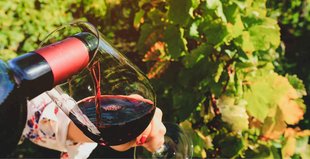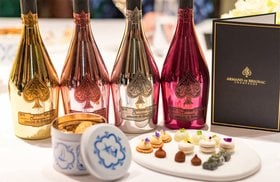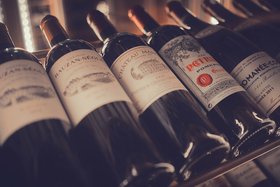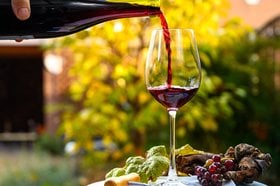Ultimate Guide To French Wine (Top 21 Wines, Regions, Terms)
Want to add the best French wine bottles to your collection?
The fascinating world of French wines is vast. The many wine names, regions, appellations, grape varieties, and so on might seem confusing indeed!
Which French wines should you try? Or add to your investment collection?
In this article, we explore everything you need to know about French wines. We’ve handpicked 21 of the best ones that you should get hold of. We’ll also tell you the easiest way to buy French wines for drinking and for investing!
Further reading
- Discover The Best Wine Brands In The World In 2022.
- If you want us to pick a wine for a celebration, try the delicious French Red Beaujolais Nouveau and the vintage champagne Dom Pérignon!
All You Need to Know About French Wine
Let’s start with how it all began.
A Brief History of French Wine
French winemaking started in the 6th century BC after the Greek settlers colonized Southern Gaul. However, it was the Romans who planted vines in all the major wine regions in the 300s.
Since then, the French wine industry continued to flourish - until mildew and Phylloxera spread in the 19th century, and entire vineyards had to be destroyed and replanted.
The following economic downturn in Europe, and the two world wars led to a depression in the French wine industry that lasted for a few decades.
In 1935, the Appellation d'origine contrôlée (AOC) was established to protect French interests. This system defined geographical wine regions and their distinct characteristics (terroir) to protect the quality of the produce and to prevent fraud.
Later, huge investments and the efforts of a new generation of French winemakers since the 1970s created the modern French wine industry as we know today.
Ever wondered what the terms terroir and appellation mean?
What is Terroir?
You may have heard a wine region being loosely referred to as terroir. But, terroir is a concept that refers to the environmental factors, including soil, climate, and altitude, in which grapes are grown. All these terroir factors combine to give a wine it’s unique flavors and aroma.
What is the Appellation System?
An appellation is a legally defined area where grapes are grown. In France, the Appellation d’Origine Contrôlée, or AOC system, strictly regulated the grape varieties that can be used in each appellation, minimum alcohol levels, how densely you can plant a vineyard, and how much it can yield.
In 2012, it was replaced by the Appellation d'Origin Protégée (AOP), which is now followed by the entire European Union.
Categories of French Wine
There are four categories or classes of French wine.
1. Appellation d'origine contrôlée (AOC), now AOP, as we saw earlier.
2. Appellation d'Origine Vin De Qualité Supérieure (AOVDQS): This falls just below AOC wines in the hierarchy. It has rules and regulations similar to AOC in terms of grape variety, amount of production, and winemaking processes.
3. Vin de pays: All the “country wines” that don’t fall under AOC appellation rules come under this category. It only has lenient rules for grape type and production methods.
4. Vin de table: “Table wines” come under this lowest category of French wines. There are no rules governing vineyard management or winemaking. You won’t see any grape varietals, vintage, or appellations listed on their wine labels.
Major Grape varieties in France
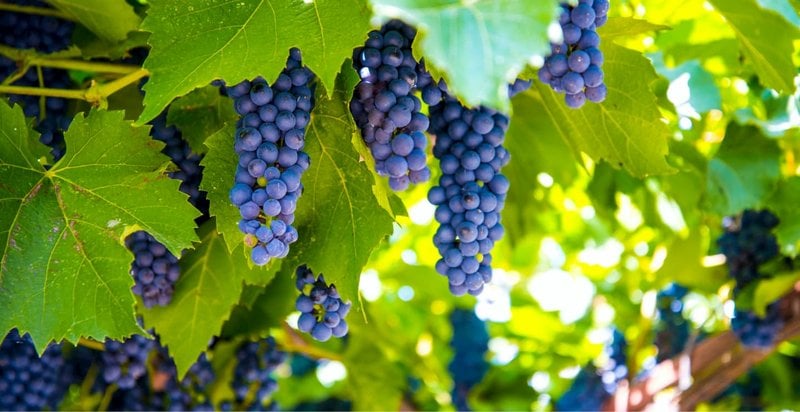
Merlot is the most planted grape varietal in France, covering 14% of the grape vine area.
The top grape varieties planted in the country are:
- Merlot
- Ugni Blanc
- Grenache
- Syrah
- Cabernet sauvignon
- Pinot Noir
- Chardonnay
- Sauvignon blanc
- Cabernet Franc
- Carignan
Wine styles produced in France
French wine can be broadly categorized into
- Red wines from grape varieties like Pinot Noir, Cabernet Sauvignon, Merlot, Zinfandel
- Rosé wines like the Provençal rosé and the sweet White Zinfandels
- White wines like a Chardonnay, Riesling, Sauvignon Blanc, or a Moscato
- Sparkling wines from Champagne and Vouvray.
To add to the complexity of picking a great wine, you’ll find that a French wine label in one region is slightly different from the other.
French Wine Labelling Practices
A Bordeaux wine label will contain the estate name and classification, appellation, bottling information, vintage, alcohol content, and volume.
On an Alsace wine label, you’ll find appellation, vineyard or parcel, grape variety, vintage, producer details, Sulfite notice, alcohol content, and volume.
And, so on.
Let’s look at the famous wine production regions in France.
Top French Wine Regions
Bordeaux and Burgundy are probably what come to your mind first! There are many more wine producing regions, including Rhone Valley, Beaujolais, Languedoc-Roussillon, and the Loire Valley.
Bordeaux
Located in southwest France, this region has 60+ growing appellations that produce mainly red Cabernet Sauvignon, Merlot, and Cabernet Franc wines. The region has a temperate, Mediterranean climate.
Besides the famous reds, the region also produces White Bordeaux made of Sauvignon Blanc, Semillon, and Muscadelle.
Burgundy
Burgundy (or Bourgogne) is a French wine region with a legacy of Pinot Noir reds, white Chardonnays, and Beaujolais Gamay wines.
Burgundy has over 100 appellations divided into Burgundy Grand Crus, Premier Crus, Village Wines, and Regional Wines.
Burgundy has five primary wine growing areas, including Chablis with its chalky terrain, Côte de Nuits, Côte Chalonnaise, Mâconnais, and Côte de Beaune near Beaune.
You’ll find red Burgundy Grand Cru vineyards in the Côte de Nuits area of Burgundy. The Corton Grand Cru Burgundy wine area is in the south of Burgundy. The smaller Jura wine area lies close to Burgundy.
Champagne
This is the northernmost wine region that lies to the east of Paris. It is known for its sparkling Blanc de Blancs and Blanc de Noirs.
Rhone Valley
Rhone Valley is famous for its Syrah and Grenache Syrah Mourvèdre (GSM) blend wines from Châteauneuf-du-Pape and Hermitage appellations, and Condrieu wines made from Viognier grapes.
The Rhone river flows through the Rhone Valley or Côtes du Rhône dividing it into Southern Rhone and Northern Rhone Valley.
Provence
Provence is a French wine region on the south-eastern coast, known for its red wines from Cabernet Sauvignon, Syrah, Cinsault, and Mourvèdre grape varieties.
Alsace
This wine region is known for its Riesling, Pinot Gris, and Gewürztraminer wines. The wines from this region are named after the grape varietal instead of the place of origin - like the Rosenhof Pinot Gris 2018.
Beaujolais
Beaujolais lies to the south of Burgundy and is famous for its fruity, vibrant, red Beaujolais Gamay wines. The unique Beaujolais flavor owes itself to the soil made fertile by the Nizerand river.
Corsica
Corsica is a French island in the Mediterranean, popular for its Pinot Noir, Tempranillo, and Barbarossa vineyards. You’ll find great wines like Patrimonio and Ajaccio, all of which have Tuscan influences.
Languedoc and Roussillon
Languedoc-Roussillon is a historical coastal area in southern France, extending from the Provence region to the Pyrenees Mountains and the Spain border. The Languedoc wine range consists of Syrah, Grenache, Carignan, Cinsault, and Mourvèdre blends.
Loire Valley
Loire Valley vineyards in the northwest produce wines like Sauvignon Blanc, Loire Vouvray, Loire Pouilly-Fume, Chinon, Marsanne, and Muscadet. The most famous Loire Valley appellation is the Sancerre with its limestone-rich Sauvignon Blanc vineyards that make dry white wines like Loire Pouilly-Fume. You’ll also find the popular Chenin Blanc Vouvrays in the Loire.
South West France
The South West or Sud-Ouest produces Malbecs, Colombard, Ugni Blanc, and Gros Manseng blends.
Now, let’s zero down on your key question: which French wines you should add to your wine collection?
21 Famous French Wines You Should Drink or Invest In
We’ve handpicked fabulous wines from France’s top chateaux - ideal for you to celebrate any occasion or to buy as a long-term investment.
1. Chateau Lafite Rothschild
The Premier Cru Classe Lafite Rothschild is made in a family-owned Chateau in the Pauillac appellation of Medoc in the Bordeaux region.
The grape varieties used are 80-95% Cabernet Sauvignon, 5-20% Merlot, 0-5% Cabernet Franc and Petit Verdot.
It is aromatic with earthy notes of truffle, spice, cedar, tobacco, lead pencil, and red berries. And, it tastes best with a minimum 15 years of bottle age.
2. Louis Roederer, Cristal
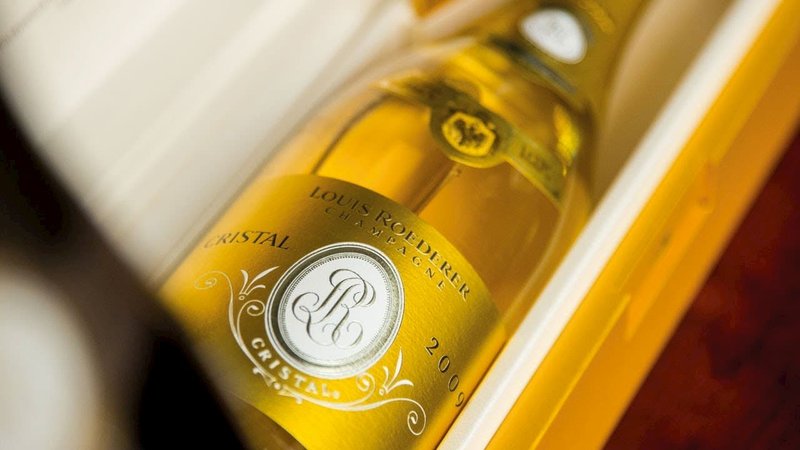
Cristal is the flagship cuvée of Louis Roederer, a family-run Maisons de Champagne in Reims.
This champagne is made from 40% Chardonnay and 60% Pinot Noir.
Drink it for it’s silky smooth texture, fruity aromas, and a strong mineral quality with citrus notes. You can easily conserve it for at least 20 years without the wine losing its freshness.
3. Chateau La Mission Haut-Brion
Chateau La Mission Haut-Brion is a red wine made in the Pessac-Léognan appellation in Bordeaux, one of the Crus Classés in the 1953 Graves classification.
The Chateau La Mission Haut Brion Blanc white wine is aged for 13-16 months.
The wines are full-bodied and concentrated with scents of truffle, smoke, earth, tobacco, and spice.
4. Chateau Beychevelle
The Chateau Beychevelle is a Quatrièmes Cru produced in the Saint-Julien appellation in the Bordeaux region.
You’ll note scents of cassis, earth, spice and tobacco in this rich, concentrated, fresh tasting Bordeaux wine.
Chateau Beychevelles are usually better with 8-12 years of bottle age.
5. Domaine de-la Romanee Conti
Widely held as one of the eminent winemakers in the world, Domaine de-la Romanee Conti (or DRC) is a winery in Burgundy that produces renowned red and white wines. The domaine is a 25-hectare Burgundy Grand Crus vineyard in which the main grape variety is Pinot Noir.
The opulent Romanee Conti wines are known to reflect the aroma of the fruit of old vines and the unique character of the terroir. In 1780, an Archbishop of Paris hailed it as “velvet and satin in bottles.”
6. Chateau Cos D’Estournel
Chateau Cos D’Estournel is a Deuxièmes Cru Bordeaux Wine produced in the Saint-Estèphe appellation of Bordeaux.
Sip this red blend, and you’ll relish the flavors of ferrous red berries and undergrowth with a spicy finish. It is a medium-bodied wine with grainy texture and moderate depth.
Typically, a Cos d’Estournel is ready for drinking after 10 to 20 years of ageing in the bottle.
7. Chapoutier Ermitage Rouge
Maison M. Chapoutier is a winemaker in Tain-l'Hermitage in the Rhône Valley wine region. Their Hermitage wines were the first to include Braille writing on their labels.
The Syrah reds from the famous Hermitage appellation are identified by the name of Ermitage Rouge. The full-bodied 2003 Ermitage Rouge, for instance, has an inky black color, with aromas and flavors of plum, licorice, and crushed rocks.
8. Fleur Petrus
Château La Fleur-Pétrus is made in Pomerol on the Right Bank of Bordeaux. It is made predominantly of Merlot, which gives it the silkiness and generosity that it’s known for. A small amount of Cabernet Franc adds rigor and complexity to the wine.
La Fleur Petrus needs at least 8-12 years of aging before you can enjoy it.
9. Chateau Montrose
Château Montrose is located in the Saint-Estèphe appellation of Bordeaux. The wines made here are classified as one of fourteen Deuxièmes Crus in the 1855 Bordeaux Wine Official Classification.
Montrose wines are a blend of 65% Cabernet Sauvignon, 25% Merlot and 10% Cabernet Franc.
The best vintages of Chateau Montrose have the ability to age for decades. Consume it after at least 10-20 years in the bottle.
10. Chateau Haut Bailly

Haut Bailly is a Graves Cru Class wine estate perched on the slopes of the Pessac-Léognan appellation in Bordeaux.
This vineyard produces only red blends with Cabernet Sauvignon (65%), Merlot (25%) and Cabernet Franc (10%).
Haut-Bailly wines like the 2011 La Parde de Haut Bailly, Pessac-Leognan are smooth and silky, with earthy notes and depth of fruit.
11. Dom Perignon
Dom Perignon is a vintage Champagne produced by Moët & Chandon, a winery and co-owner of the luxury goods firm Moët Hennessy Louis Vuitton. It is named after a 17th-century Benedectine monk who was one of the pioneers for Champagne wine.
The wine is 60% Chardonnay grapes and 40% Pinot Noir. Notably, each bottle contains grapes only from a single year - and you won’t find a non-vintage Dom Perignon.
12. Chateau Smith Haut Lafitte
Smith Haut Lafitte is a Crus Classé Bordeaux wine from the Pessac-Léognan appellation.
You’ll find red wines like the 2010 Smith Haut Lafitte Rouge with a silky texture and aromatic charm, and white Sauvignon Blanc wines that are elegant, with woody and citrus notes.
Remember, it should age in the bottle for a minimum of 8-10 years before you open the bottle.
13. Chateau Pichon Lalande
Pichon Lalande are Deuxièmes Cru (Second Growth) wines made in Louis Roederer’s vineyard in Pauillac, Bordeaux.
A Pichon Lalande tastes best with at least 10-12 years of bottle age and matures between 15-40 years of age after the vintage.
As for the flavor, you’ll taste dark berry, truffle, cassis, and cedar with silky, velvet textures.
14. Chateau Y’Quem
Chateau Y’Quem is a Premier Cru Supérieur wine from the Sauternes in the Graves region of Bordeaux.
The winemaking process involves picking only fully botrytized fruit with such low yields that each vine can produce just one glass of wine.
These sweet wines made from Sémillon and Sauvignon Blanc are characterised by their complexity, concentration, and high acidity.
15. Chateau Troplong Mondot
The Premier Grand Cru classé Chateau Troplong Mondot is produced in the Saint-Émilion appellation in Right Bank Bordeaux.
Chateau Troplong Mondot is unique in its thick, sensuous flavor with scents of dark plums, licorice, coffee, spice, blackberries, stone, chocolate, and flowers. It is best enjoyed after 8-10 years of bottle age.
16. Bollinger RD
Bollinger RD is a sparkling wine made by Bollinger in Champagne. RD or récemment dégorgé, meaning "recently disgorged", sits eight years on its lees (deposits of residual yeast and other particles), which gives rise to complex flavors.
On its labels, you’ll find the disgorgement date (the date on which the sediments were eliminated.)
A Bollinger RD is usually shipped ready for your consumption.
17. Chateau Conseillante
Chateau Conseillante or La Conseillante, is a Bordeaux wine from the Pomerol appellation. Although the wines are unclassified, this estate is among the crème de la crème of Pomerol winemakers.
The average age of the harmonious, refined and velvety Chateau La Conseillante is 34 years. The wine lover in you will love its scents of plum, dark cherry, flowers, black raspberry, and chocolate.
18. Chateau Pontet Canet
The red Chateau Pontet Canet is a Cinquièmes Cru produced in a vineyard by the same name in the Pauillac appellation of Bordeaux.
Interestingly, you’ll find horses turning the soil in the Pontet Canet vineyard, instead of tractors, because they don’t step in the same place twice, aerating the soil better.
This powerful Bordeaux wine is concentrated, balanced, and tannic, and tastes best after 10 years of bottle age.
19. Chateau Lynch Bages
The red wine Chateau Lynch Bages is another Cinquièmes Cru made in Pauillac, Bordeaux.
The wine’s distinctive character, deep color, tannic backbone, and supple and smooth structure are part of its signature style. It needs 15-20 years to show its best and gives you flavors of wet earth, cassis, tobacco, and truffle.
20. Chateau Câlon Ségur
Chateau Câlon Ségur wines are made in the Saint-Estèphe wine production region of Bordeaux.
They are usually made up of 78% Cabernet Sauvignon, 20% Merlot, and 2% Petit Verdot.
These Troisièmes Crus Classé (Third Growth) wines evolve and age extremely well. The lush, ripe, and refined wines are best enjoyed after 10-15 years in the bottle.
21. Taittinger
Taittinger is a French vineyard in Reims that produces the Comtes de Champagne, and the non-vintage Brut Reserve.
The Brut Reserve is 40% Chardonnay, 35% Pinot Noir, and 25% Pinot Meunier with fresh fruit and bread notes. Comtes de Champagne is 100% Chardonnay grapes, and Comtes de Champagne Rosé is made of 70% Pinot Noir and 30% Chardonnay.
The French wine world is fascinating and overwhelming at the same time, isn’t it?
So, how do you get hold of the best French wines?
Here’s the easiest way to do it:
Buy French Wine through Vinovest (for Drinking and Investing)
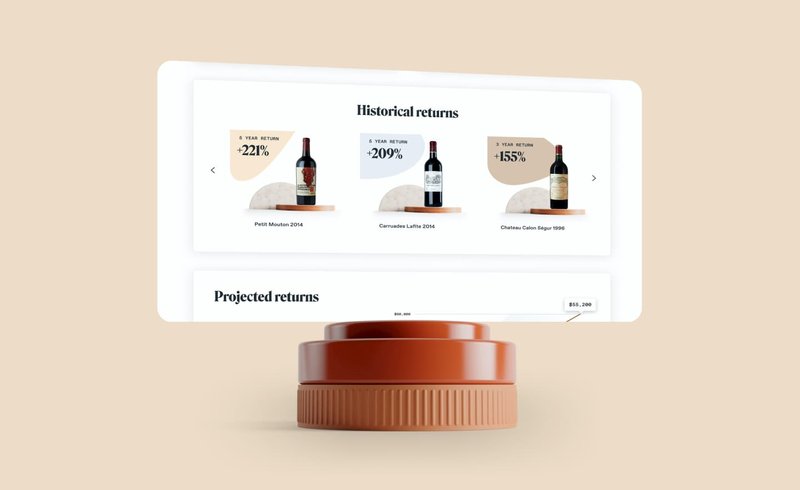
Vinovest is a wine investment company that lets you buy fine wines from anywhere in the world, including French wines from Burgundy, Loire, and Rhone Valley.
Vinovest will also store your bottles safely, and deliver them to you for drinking whenever you need them.
Know what the best part is?
You can sell these wine bottles later for a profit if you wish to!
How does it work?
It’s super simple - just follow these four steps:
- Sign up
- Answer a questionnaire on your risk appetite and investment preferences.
- Fund your account with a minimum of $1,000.
- Track your portfolio online as it grows over time.
What are the benefits of buying French wines through Vinovest?
Vinovest will select, authenticate for genuineness, buy, store, deliver, and sell your French wines for you.
Here’s what you’ll benefit from:
Easy buying
You can easily buy French wines from Burgundy, Loire, Rhone, Beaujolais, or any other part of the world like Napa Valley, using Vinovest’s intelligent online platform.
Best Prices
Vinovest sources wines directly from winemakers, global wine exchanges, and wine merchants - so you get the bottles at the best possible wholesale prices.
Tracing provenance and authenticity
Rest assured, you won’t be scammed with counterfeit wines. Vinovest will carefully authenticate your wines and trace their provenance before you decide to buy them.
Portfolio curated by experts
Vinovest lets you build a high-performing investment portfolio of wines. This will be curated by an Advanced Sommelier and three Master Sommeliers, with the help of an Artificial Intelligence-based software tool.
Storage under perfect conditions
If you need the wine bottles to be stored for an extended period, Vinovest will store them in bonded warehouses. Your bottles will be safe under optimal conditions of light, humidity, temperature, and vibration.
Low overall costs
You’ll need to fund your account. Besides that, the only other expense would be a 2.5% annual fee (1.9% for a portfolio above $50,000).
This fee will cover buying your wines, authentication, storage, a full insurance policy at market value, portfolio management, and wine selling. You’ll benefit from significant tax advantages because bonded warehouses don’t charge VAT or excise duty.
Ownership
You get full ownership of the wines you buy.
Easy delivery of wines
In case you want to open your wine bottles for a special occasion, you can have them delivered to your home easily.
Easy selling of wines
Easily sell your wine collection if you wish to make a profit. Once you do, Vinovest will deliver the wines to the counterparty buyer.
The platform makes it easy for you to sell your wines at any time. But if you’re looking for the best returns, you should sell your wine when it reaches its peak value (after 5-20 years.)
Our advisors will work with you to maximize your returns - no matter the market conditions. They’ll also guide you on the best liquidy options and the best time to sell your wines.
Doesn’t it sound way simpler than finding, buying, and storing the wine bottles yourself?
Wrapping up
There are plenty of renowned French wines that’ll make fabulous additions to your wine collection.
But you definitely don’t want to get stuck wondering which wines to buy and how.
Vinovest makes it incredibly simple for you to buy sought-after French wines, for you to drink or to invest in.
So, sign up now and start building your winning wine portfolio right away!
